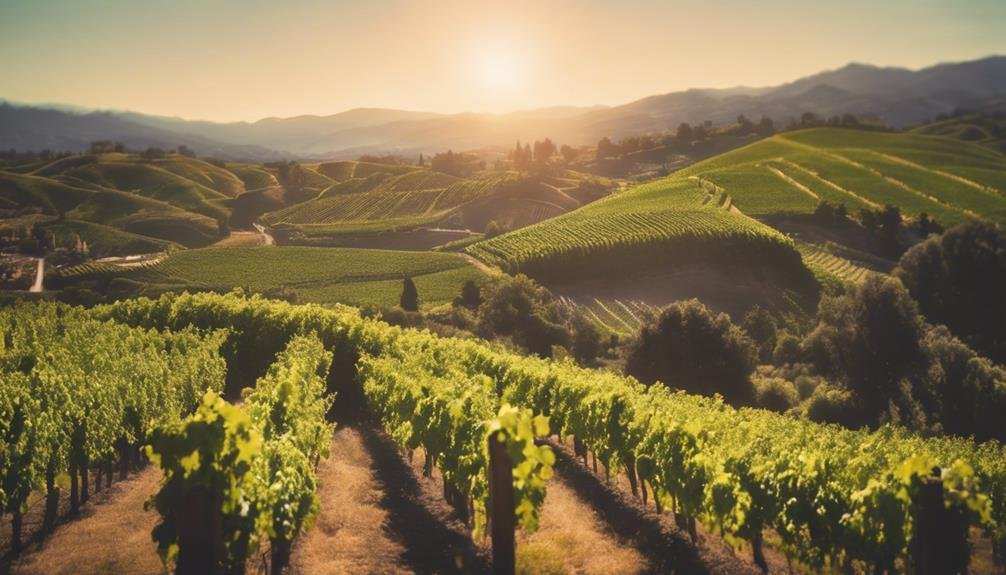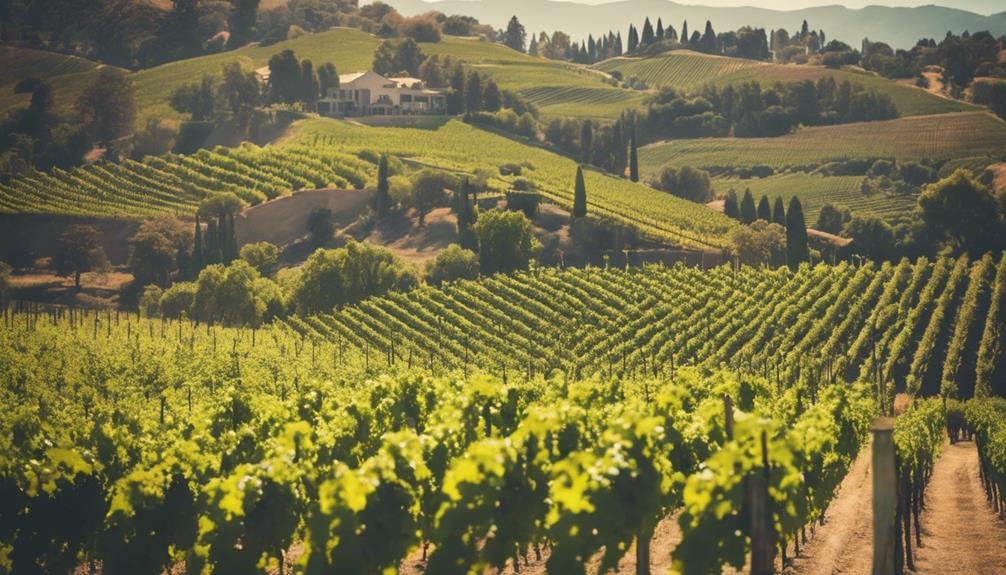Originating in Bordeaux and making its mark in regions like Loire Valley, Tuscany, and California, this red wine offers complexity at affordable prices, with different regional styles ranging from light and herbaceous to rich and spicy. Influenced by Napa Valley‘s warm climate, it presents ripe, jammy fruit flavors with high alcohol content and big tannins. Pair it with dishes like steak burritos or chili for a delightful experience. Cabernet Franc’s adaptability to various winemaking styles and increasing popularity among wine drinkers hint at its promising future. Uncover the nuances of this appealing wine.
History and Significance of Cabernet Franc
With a rich history deeply intertwined with winemaking traditions, Cabernet Franc holds significant importance in the world of wine. Originating in the Bordeaux region of France, Cabernet Franc has made a lasting cultural impact globally, particularly in regions like the Loire Valley, Tuscany, and California.
This grape variety is known for its versatility, being used both as a blending grape in Bordeaux wines and as a successful single varietal in various regions. Cabernet Franc’s influence can be seen in the different regional styles it produces, ranging from light and herbaceous in the Loire Valley to rich and spicy in Tuscany.
Its ability to offer complexity and structure at reasonable prices has further solidified its place in the wine world, despite often being overshadowed by more popular varietals like Cabernet Sauvignon and Merlot.
Regional Styles and Characteristics
Cabernet Franc’s impact on regional winemaking styles and characteristics is evident in the diverse expressions it embodies across different wine-producing regions. Regional diversity brings forth variations in flavor profiles, allowing for intriguing comparisons.
For instance, the grape showcases light and herbaceous notes in the Loire Valley, while Tuscany offers a richer and spicier interpretation. In California, Cabernet Franc strikes a balance between ripe red fruit, green elements, pepper, and spice. Each region adds its own nuances to the varietal, creating a tapestry of flavors that cater to different preferences.
Understanding these regional styles enriches the wine enthusiast’s experience, providing a deeper appreciation for the complexity and versatility of Cabernet Franc.
Influence of Napa Valley Climate

The climatic conditions in Napa Valley play a significant role in shaping the characteristics of Cabernet Franc produced in the region. Napa’s impact on Cabernet Franc is evident in the wines’ flavor profiles, with the warm climate leading to ripe, sweet grapes that result in high alcohol content, big tannins, and rich, jammy fruit flavors.
When tasting Napa Valley Cabernet Franc, expect notes of red raspberry, strawberry, roasted pepper, and a hint of spiciness from oak aging. These wines share similarities with the popular Cabernet Sauvignons from Napa, offering a balance of structure and complexity at accessible prices.
Napa Valley’s influence on Cabernet Franc showcases the region’s ability to produce wines with depth and character that reflect the unique terroir.
Tasting Notes and Food Pairings
An examination of the sensory attributes and culinary companions of American Cabernet Franc reveals its versatile nature and potential for enhancing dining experiences. When exploring this wine, consider the following:
- Flavor Profiles: American Cabernet Franc typically presents a mix of ripe red fruit, green notes, pepper, and spice. These diverse flavors provide a complex tasting experience worth investigating.
- Wine Pairing: Experimentation is key when pairing American Cabernet Franc. It complements a variety of dishes, such as steak burritos, chili, and stuffed peppers, enhancing the flavors of both the wine and the food.
- Exploration: Immerse yourself in the world of food and wine pairing with American Cabernet Franc to uncover a myriad of delightful taste combinations. Let your palate guide you as you discover the perfect matches for this versatile wine.
Value and Future of Cabernet Franc

Regarding the value and future of Cabernet Franc, an exploration into its evolving presence in the wine industry reveals promising prospects for this versatile varietal. Value appreciation is evident as more consumers recognize the exceptional quality and affordability of Cabernet Franc wines across different regions. Emerging trends indicate a growing interest in this grape variety, with winemakers experimenting with new techniques to showcase its unique characteristics. The table below highlights key aspects contributing to the value and future of Cabernet Franc:
| Aspect | Description | Impact |
|---|---|---|
| Quality | Offers complexity at reasonable prices | Attracts wine enthusiasts |
| Versatility | Adaptable to various winemaking styles | Appeals to diverse consumer preferences |
| Sustainability | Thrives in different climates and soils | Secures long-term cultivation success |
| Market Demand | Increasing popularity among wine drinkers | Drives production and innovation |
Frequently Asked Questions
How Does Cabernet Franc Compare to Other Popular Red Wine Varietals?
Cabernet Franc stands out with diverse flavor profiles from regions like Loire Valley’s light, herbaceous style to California’s ripe red fruit and Napa’s bold tannins. Its complexity, structure, and reasonable prices make it a compelling choice among red varietals.
Are There Any Famous Wineries Known for Their Cabernet Franc Production?
Famous wineries known for their Cabernet Franc production include Château Cheval Blanc in Bordeaux, known for its exceptional blends, and Elyse Winery in Napa Valley, renowned for crafting rich and structured Cabernet Franc wines.
What Makes Cabernet Franc a Versatile Wine for Food Pairing?
Cabernet Franc’s versatility in food pairing stems from its diverse flavors, featuring red fruit, green notes, pepper, and spice. The sensory experience of exploring these flavors enhances dining, making it an excellent choice for a wide range of dishes.
How Does the Aging Potential of Cabernet Franc Differ From Other Red Wines?
Cabernet Franc’s aging potential varies due to its tannin structure and acidity balance. With proper cellaring, it develops flavors over time, offering complexity. It ages gracefully, showcasing its versatility in flavor development, making it a standout among red wines.
Are There Any Unique Winemaking Techniques Specific to Cabernet Franc Production?
Fermentation techniques and aging processes in Cabernet Franc production embrace tradition while adapting to modern innovations. Soil influences and climate variations shape the grape’s character, resulting in a wine that captivates with complexity and depth.
Conclusion
In the world of American Cabernet Franc, each region paints a unique portrait of this versatile grape. From the light and herbaceous styles of the Loire Valley to the bold and ripe expressions of Napa Valley.
As enthusiasts continue to explore the diverse offerings beyond California’s borders, the treasure trove of complexity and value within Cabernet Franc promises a journey of discovery and delight for wine connoisseurs.
